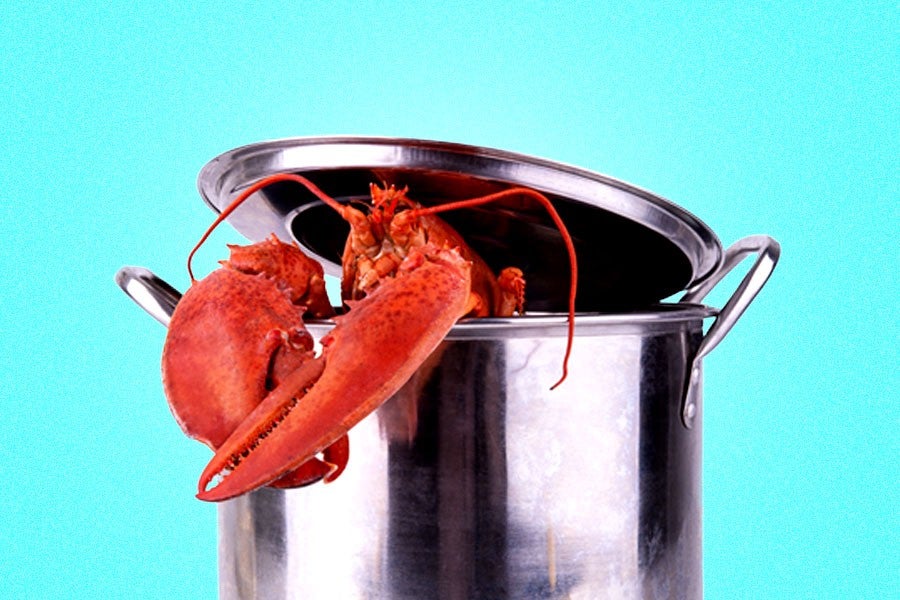The Swiss government recently banned the common culinary practice of plunging live lobsters into boiling water. According to Swiss public broadcaster RTS, the new measure demands that lobsters be stunned—either by electric shock or “mechanical destruction” of the brain—before being boiled.
The law also provides lobsters with protections while in transit: “Live crustaceans, including the lobster, may no longer be transported on ice or in ice water. Aquatic species must always be kept in their natural environment [saltwater].”
In response to this new order, U.K.-based animal welfare organization Crustacean Compassion released a petition calling on the British government to outlaw the practice of boiling (and dismembering) lobsters alive. Thus far, more than 37,000 signatures—including high-profile campaigners and celebrities—have been added.
Maisie Tomlinson, co-founder of Crustacean Compassion, also wants restaurants to upgrade their lobster tanks. “They should be kept in more natural environments, not crammed together in overcrowded tanks (or kept for hours on ice),” she says. “Many species of lobster are unable to adequately consume oxygen in the air, and they’re solitary creatures—it’s highly likely these practices are incredibly stressful for them.”
With all this in mind, did we ever really need to boil lobsters alive in the first place? It’s certainly true that lobster meat spoils quickly once the lobster is dead, which is why they must be transported alive (and kept alive in lobster tanks before being served). More specifically, lobsters and other shellfish have dangerous bacteria in their flesh, which multiply and release toxins upon death. So cooking the lobster alive (or very shortly after being killed) is your best bet for avoiding a nasty case of food poisoning.
But it’s that latter distinction—between “boiled alive” and “humanely killed, then boiled”—that has people arguing. Both the Swiss law and the British petition argue that lobsters are sentient beings, and therefore, shouldn’t suffer unnecessarily. Per the petition: “Scientific evidence has now demonstrated that crabs, lobsters, prawns and crayfish are highly likely to experience pain and even emotional anxiety.”
PETA also released a statement applauding the ban: “When they’re plunged into scalding-hot water, [crustaceans] can be seen writhing wildly and scraping at the sides of the pot in a desperate attempt to escape. To anyone in a civilized society, this legislation makes sense.”
Many researchers traditionally contend that crustaceans don’t experience pain, arguing that lobsters have a primitive nervous system incapable of processing it. “For an organism to perceive pain it must have a complex nervous system,” according to the Lobster Institute. “Neurophysiologists tell us that lobsters, like insects, do not process pain.”
But science has indeed begun to suggest otherwise. A 2013 study published in the Journal of Experimental Biology found that hermit crabs (which are closely related to lobsters) abandon their shelters when exposed to electric shock. “The animals will pay a high price by leaving desired resources in order to get away from noxious stimulus,” says researcher Robert Elwood, suggesting that crustaceans will deliberately attempt to avoid painful situations. “They remember and learn very quickly to avoid places where they have received noxious treatment.”
Of course, we can’t prove it either way—lobsters, as far as we know, are incapable of telling us whether they feel pain. But Elwood argues that we have an ethical responsibility to “err on the side of caution when data is consistent with the idea of pain.”
That means adopting more humane methods of killing, according to Tomlinson. She first recommends the (somewhat comically-named) Crustastun, which knocks the animal unconscious within a fraction of a second. (Crustastun also claims that the reduced stress associated with its method enhances texture and flavor.) Tomlinson suggests that another option is the mechanical destruction of the brain with a sharp knife, which requires that chefs swiftly slice from head to tail to sever the chains of ganglia (structures containing nerve cells) that run through the body. Both methods appear to be extremely straightforward—and have virtually zero impact on the freshness of the lobster—considering their proposed impact: Fewer tortured lobsters.
Tanja Florenthal, academic director of the César Ritz Colleges in Switzerland, told The Washington Post that instructors at the Culinary Arts Academy Switzerland have already implemented such methods into their lessons. “Unfortunately, we’ve been teaching them to do it with boiling water; but that’s changing now,” she said. “We are going to take this opportunity to have a discussion with the students to see if there are other ways to do the killings in a more ethical and respectful manner, not only for lobsters.”
Only time will tell whether other countries will follow Switzerland’s example, although Elwood is optimistic. “Switzerland has examined the data from experiments and come to a conclusion that some protection be given against potential suffering,” says Elwood. “I have little doubt that other countries will follow in that respect.”
Tomlinson adds that many countries—Norway, Switzerland, Austria, New Zealand and some Australian territories—already place restrictions on the inhumane treatment of lobsters. And cities in Germany and Italy, she says, have explicitly banned the practice of boiling lobsters alive. “The U.K. often thinks of itself as a world leader in animal welfare, but we’re behind the times with this issue,” she says. “Change is long overdue.”

